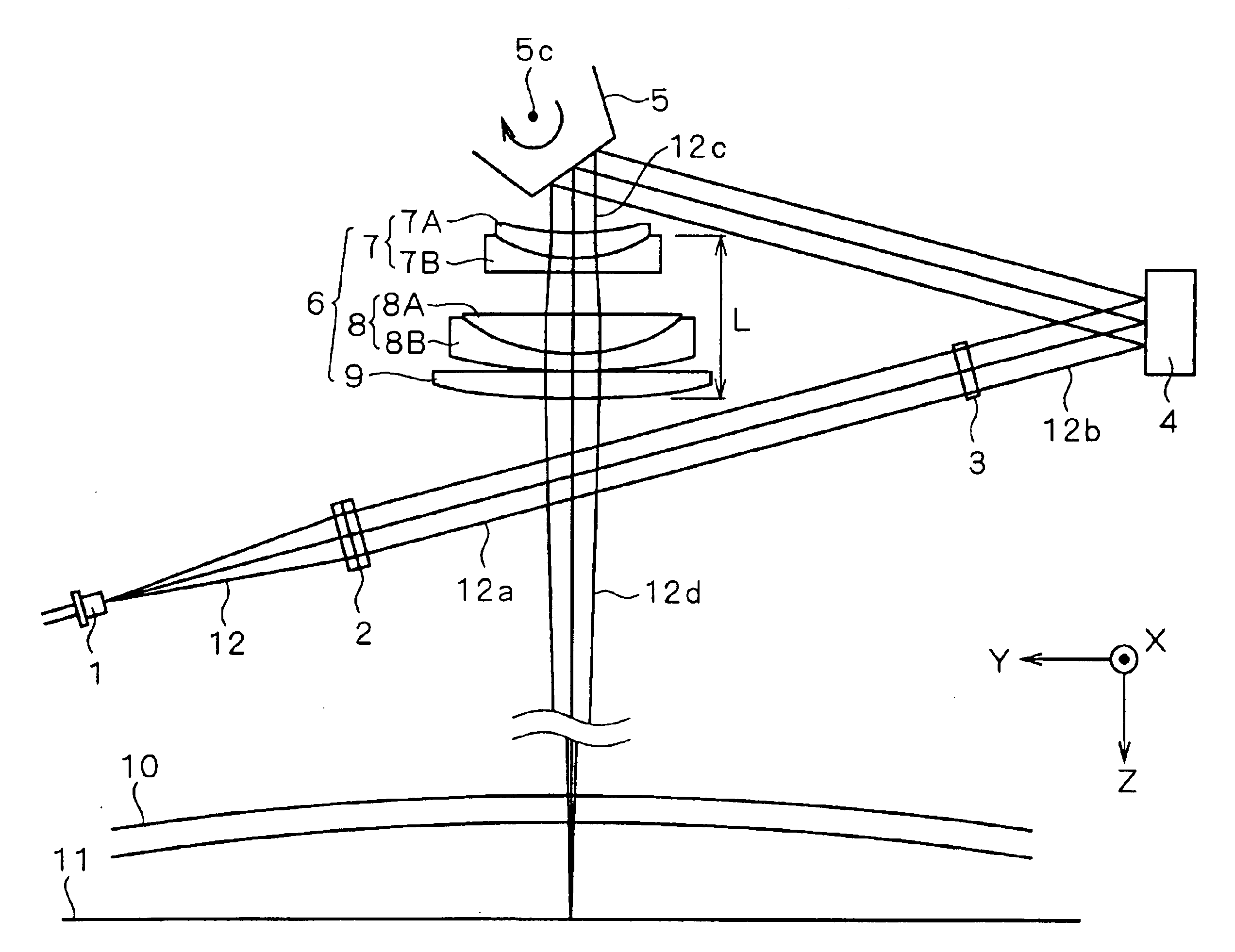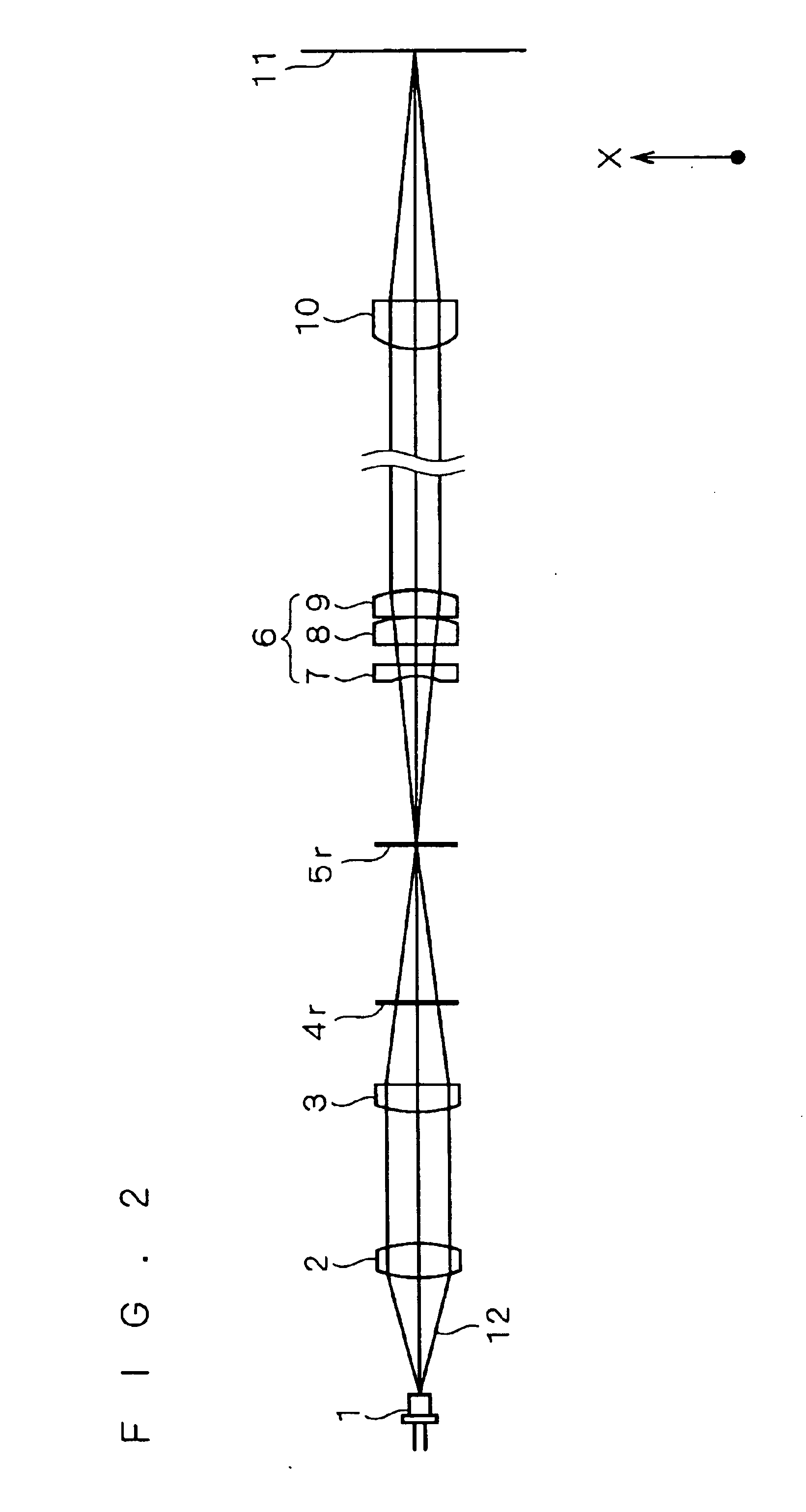Optical scanner
a scanner and optical technology, applied in the field of optical scanners, can solve the problems of reducing image resolution and no stable beam spot on the objective surface, and achieve the effect of high optical performan
- Summary
- Abstract
- Description
- Claims
- Application Information
AI Technical Summary
Benefits of technology
Problems solved by technology
Method used
Image
Examples
first preferred embodiment
An f-θ lens 6 according to a first preferred embodiment of the present invention is designed to be preferable as to a light beam having a working wave range of a central wavelength of 405 nm, a maximum wavelength of 410 nm and a minimum wavelength of 400 nm. In order to optimize optical performance with respect to this working wave range in particular, the f-θ lens 6 preferably satisfies the following conditional expressions (2A), (4A), (5A) and (6A): 0.04≤r1r4≤0.17(2A)0.48≤v1v2≤0.58(4A)0.42≤v4v3≤0.47(5A)0.24≤f1f≤0.32(6A)
first example
An f-θ lens 6 according to a first example of this embodiment is now described. FIG. 3 is a schematic sectional view of the f-θ lens 6 according to the first example. Table 1 shows the focal distance f, the F-number and the total angle θ of view of the f-θ lens 6 according to the first example and a working wave range of a laser beam oscillated in a light source 1.
TABLE 1F-NumberF / 41Focal Distance (f)f = 693.5 mmTotal Angle of View (θ)45.44°Central Wavelength (λ0)λ0 = 405 nmUpper Limit of Working Wave Range (λmax)λmax = 410 nmLower Limit of Working Wave Range (λmin)λmin = 400 nm
Table 2 shows values indicating optical characteristics of the f-θ lens 6 according to the first example.
TABLE 2ir(i)d(i)nd(i)νd(i)1−120.49.81.6258835.72−46.755.01.6073856.83∞17.44−2150.015.31.6030065.55−66.647.01.6476933.86−181.00.57−1172.010.01.6516058.58−214.7
As shown in FIG. 3, first to fifth lenses 7A to 9 have refracting interfaces S1, S2, S3, S4, S5, S6, S7 and S8 respectively. Table 2 shows the radii ...
second example
An f-θ lens 6 according to a second example of the first preferred embodiment is now described. FIG. 13 is a schematic sectional view of the f-θ lens 6 according to the second example. Table 5 shows the focal distance f, the F-number and the total angle θ of view of the f-θ lens 6 according to the second example and a working wave range of a laser beam oscillated in a light source 1.
TABLE 5F-NumberF / 41Focal Distance (f)f = 692.5 mmTotal Angle of View (θ)45.5°Central Wavelength (λ0)λ0 = 405 nmUpper Limit of Working Wave Range (λmax)λmax = 410 nmLower Limit of Working Wave Range (λmin)λmin = 400 nm
Table 6 shows values indicating optical characteristics of the f-θ lens 6 according to the second example.
TABLE 6ir(i)d(i)nd(i)νd(i)1−116.0793611.9594321.6398034.52−42.269025.0000001.6223053.23∞14.3456174−2431.0510715.8572961.6180063.45−64.824067.0000001.6727032.16−159.278330.8376547−1762.1081410.0000001.6400060.18−248.71440
Numerical values of various ratios used in the above conditional exp...
PUM
 Login to View More
Login to View More Abstract
Description
Claims
Application Information
 Login to View More
Login to View More - R&D
- Intellectual Property
- Life Sciences
- Materials
- Tech Scout
- Unparalleled Data Quality
- Higher Quality Content
- 60% Fewer Hallucinations
Browse by: Latest US Patents, China's latest patents, Technical Efficacy Thesaurus, Application Domain, Technology Topic, Popular Technical Reports.
© 2025 PatSnap. All rights reserved.Legal|Privacy policy|Modern Slavery Act Transparency Statement|Sitemap|About US| Contact US: help@patsnap.com



